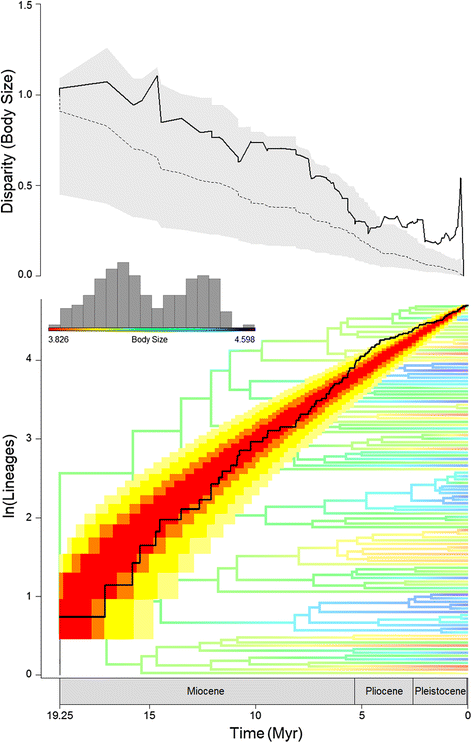What defines an adaptive radiation? Macroevolutionary diversification dynamics of an exceptionally species-rich continental lizard radiation
- PMID: 26245280
- PMCID: PMC4527223
- DOI: 10.1186/s12862-015-0435-9
What defines an adaptive radiation? Macroevolutionary diversification dynamics of an exceptionally species-rich continental lizard radiation
Abstract
Background: Adaptive radiation theory posits that ecological opportunity promotes rapid proliferation of phylogenetic and ecological diversity. Given that adaptive radiation proceeds via occupation of available niche space in newly accessed ecological zones, theory predicts that: (i) evolutionary diversification follows an 'early-burst' process, i.e., it accelerates early in the history of a clade (when available niche space facilitates speciation), and subsequently slows down as niche space becomes saturated by new species; and (ii) phylogenetic branching is accompanied by diversification of ecologically relevant phenotypic traits among newly evolving species. Here, we employ macroevolutionary phylogenetic model-selection analyses to address these two predictions about evolutionary diversification using one of the most exceptionally species-rich and ecologically diverse lineages of living vertebrates, the South American lizard genus Liolaemus.
Results: Our phylogenetic analyses lend support to a density-dependent lineage diversification model. However, the lineage through-time diversification curve does not provide strong support for an early burst. In contrast, the evolution of phenotypic (body size) relative disparity is high, significantly different from a Brownian model during approximately the last 5 million years of Liolaemus evolution. Model-fitting analyses also reject the 'early-burst' model of phenotypic evolution, and instead favour stabilizing selection (Ornstein-Uhlenbeck, with three peaks identified) as the best model for body size diversification. Finally, diversification rates tend to increase with smaller body size.
Conclusions: Liolaemus have diversified under a density-dependent process with slightly pronounced apparent episodic pulses of lineage accumulation, which are compatible with the expected episodic ecological opportunity created by gradual uplifts of the Andes over the last ~25My. We argue that ecological opportunity can be strong and a crucial driver of adaptive radiations in continents, but may emerge less frequently (compared to islands) when major events (e.g., climatic, geographic) significantly modify environments. In contrast, body size diversification conforms to an Ornstein-Uhlenbeck model with multiple trait optima. Despite this asymmetric diversification between both lineages and phenotype, links are expected to exist between the two processes, as shown by our trait-dependent analyses of diversification. We finally suggest that the definition of adaptive radiation should not be conditioned by the existence of early-bursts of diversification, and should instead be generalized to lineages in which species and ecological diversity have evolved from a single ancestor.
Figures



Similar articles
-
Macroevolutionary diversification with limited niche disparity in a species-rich lineage of cold-climate lizards.BMC Evol Biol. 2018 Feb 6;18(1):16. doi: 10.1186/s12862-018-1133-1. BMC Evol Biol. 2018. PMID: 29409440 Free PMC article.
-
Tightly congruent bursts of lineage and phenotypic diversification identified in a continental ant radiation.Evolution. 2016 Apr;70(4):903-12. doi: 10.1111/evo.12894. Epub 2016 Mar 29. Evolution. 2016. PMID: 26935139
-
Live fast, diversify non-adaptively: evolutionary diversification of exceptionally short-lived annual killifishes.BMC Evol Biol. 2019 Jan 9;19(1):10. doi: 10.1186/s12862-019-1344-0. BMC Evol Biol. 2019. PMID: 30626330 Free PMC article.
-
Adaptive radiation versus 'radiation' and 'explosive diversification': why conceptual distinctions are fundamental to understanding evolution.New Phytol. 2015 Jul;207(2):297-303. doi: 10.1111/nph.13482. Epub 2015 Jun 1. New Phytol. 2015. PMID: 26032979 Review.
-
Phylogenetic tests for evolutionary innovation: the problematic link between key innovations and exceptional diversification.Philos Trans R Soc Lond B Biol Sci. 2017 Dec 5;372(1735):20160417. doi: 10.1098/rstb.2016.0417. Philos Trans R Soc Lond B Biol Sci. 2017. PMID: 29061890 Free PMC article. Review.
Cited by
-
The Macroecology of Chemical Communication in Lizards: Do Climatic Factors Drive the Evolution of Signalling Glands?Evol Biol. 2018;45(3):259-267. doi: 10.1007/s11692-018-9447-x. Epub 2018 Mar 10. Evol Biol. 2018. PMID: 30147195 Free PMC article.
-
Description and phylogeny of a new species of Liolaemus (Iguania: Liolaemidae) endemic to the south of the Plurinational State of Bolivia.PLoS One. 2019 Dec 2;14(12):e0225815. doi: 10.1371/journal.pone.0225815. eCollection 2019. PLoS One. 2019. PMID: 31790476 Free PMC article.
-
Convergence across a continent: adaptive diversification in a recent radiation of Australian lizards.Proc Biol Sci. 2016 Jun 15;283(1832):20160181. doi: 10.1098/rspb.2016.0181. Proc Biol Sci. 2016. PMID: 27306048 Free PMC article.
-
Island woodiness underpins accelerated disparification in plant radiations.New Phytol. 2019 Oct;224(1):518-531. doi: 10.1111/nph.15797. Epub 2019 Apr 10. New Phytol. 2019. PMID: 30883788 Free PMC article.
-
Anatomy of a Neotropical insect radiation.BMC Evol Biol. 2018 Mar 14;18(1):30. doi: 10.1186/s12862-018-1146-9. BMC Evol Biol. 2018. PMID: 29540154 Free PMC article.
References
-
- Losos JB. Lizards in an evolutionary tree. Ecology and adaptive radiation of anoles. Berkeley: University of California Press; 2009.
-
- Schluter D. The ecology of adaptive radiation. Oxford: Oxford University Press; 2000.
-
- Galis F. Key innovations and radiations. In: Wagner GP, editor. The character concept in evolutionary biology. San Diego: Academic; 2001. pp. 583–607.
Publication types
MeSH terms
LinkOut - more resources
Full Text Sources
Other Literature Sources

